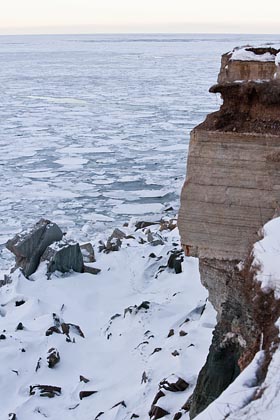One year's eco-birdwatching experience without knowing it
Unwitting eco-rallyer Maret
Photo: Arne Ader
Translation: Liis
Pakri cliff
It was a pleasant surprise to discover the notice in Looduskalender about the "Ökoralli 2014“. Unknown to myself I have counted birds for a year true to the ecorally rules. And the reason and inevitable fact is quite simply that I don’t have a motor vehicle ...
As a novice birdwatcher I registered in January 2013, identified somewhere around 130 species during the year, and made all observations mostly on foot (up to 17 km), sometimes on bicycle, and in winter with a dog sled. I don’t know if I am the only ”dog power user”? It wasn’t really much more comfortable or successful by bike, only when I wanted to see something in a particular spot.
On bird trips Murphy helps – an Alaskan Malamute. Seeing a bird the dog stops, one forepaw in air and the muzzle towards the find. Then I see it too. With larger, hidden, silent birds he is a great help (owls, black grouse, pigeons, partridges) in apprehending them. A malamute doesn’t bark so he doesn’t disturb the birds. Even the magpies (Pica pica) of Pakri won’t go off chattering to warn the others, knowing that we are harmless characters. But there is no point in watching seabirds with him. Restless, as all malamutes, doesn’t like to stay still, starts howling like a wolf at the top of his voice whereupon all the winged inhabitants of the Pakri peninsula rise into flight. Even the flocks of long-tailed ducks (Clangula hyemalis) in the bay waters. At Pakri is where we live. It is another thing to ride by dog sledge at ICE TIME on the Paldiski bay, then one sees and experiences enough. And particularly exciting for the dog when we happen to stop on a drifting ice floe ...
My "nest" is an apartment on the second floor. During last year I counted 56 bird species comfortably alongside my morning coffee. We have a droll creature, a blackheaded gull (Larus ridibundus), called Baleriina – holds its legs as a ballerina during flight. My neighbour feeds it. When it wants food it gives notice by chucking a splash on the window. The splat, you know of what, that of a herring gull (Larus argentatus) shuts out light. So the black-headed gull is a winter garden bird at our place.
The best picture from bird life from the window last year was when a sparrowhawk (Accipiter nisus) flew into the spaces behind the rain gutters to hunt sparrows. I don’t hold with the activities of our local ”murderous” sparrowhawk at all, but then I admired the cleverness of the hawk.
Fresh impression from this year. I was almost going to attack a great spotted woodpecker (Dendrocopos major) with the flyswatter. I have a so-called feeding bush with a plastic bucket with a hole in it, where many kinds of tits, sparrows and even redpolls (Carduelis flammea) come to eat when snow is on the ground. I stopped hanging fat balls in the bush because the greedy hooded crows (Corvus corone cornix) at once grab them. So I hung the fat balls under the windowsill on the second floor. There together on the ball swinging in the wind tits and sparrows hang. But a few days ago came the voracious female great spotted woodpecker and gobbled up the fat ball faster than a crow – what a monster but so beautiful up close.
For sharing impressions and experiences among Ökoralli 2014 entrants we have set up a joint blog at the address:
In addition to the blog posts there is a current ranking list and detailed rules for the eco-rally. For anyone who would like to take part in the Ökoralli 2014, the event is open to all. You simply need to read the rules and inform us of your wish to participate:









